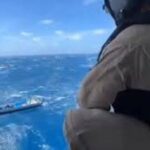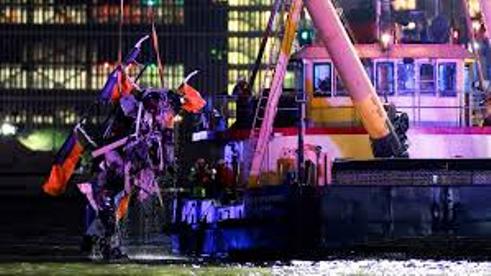LAGOS APRIL 11H (NEWSRANGERS)-A family’s afternoon sightseeing excursion above the misty shoreline of Manhattan ended in tragedy Thursday after the helicopter carrying them crashed off the New Jersey shoreline, killing them and the pilot.
Spectators watched the helicopter as it dropped from the sky and slammed into the river upside down as fluttering debris landed in the water.
The victims included Agustín Escobar, a Siemens executive, and his family, according to a law enforcement official. The family was visiting from Spain, New York Mayor Eric Adams said during a news conference Thursday. CNN has reached out to the New York Police Department and the US Coast Guard for more information on the victims.
While not much is known about why the helicopter crashed, its staggering descent from the sky shocked witnesses as first responders did what they could to rescue the victims.
At 3:17 p.m., multiple 911 calls reported a helicopter crash in the Hudson River near the New Jersey coastline at Pier A Park in Hoboken, New York Police Department Commissioner Jessica Tisch said. When first responders arrived, police pulled four people out of the water and FDNY pulled out two people, she said.
Four victims were declared dead on scene and an additional two people were taken to local hospitals, Tisch said. Two children were taken to the Jersey City Medical Center before being pronounced dead, Jersey City Mayor Steven Fulop said on X.
“Our hearts go out to the family of those who were on board,” Adams said.
President Donald Trump also sent his condolences via a Truth Social post, saying “God bless the families and friends of the victims” and that Secretary of Transportation Sean Duffy was looking into the incident.
The helicopter, operated by the tour company New York Helicopter Charter, is currently submerged in the river.
“The only thing I can tell you is that we are devastated,” Michael Roth, the CEO of New York Helicopter Charter Inc., told CNN Thursday evening.
“I’m a father, a grandfather and my wife hasn’t stopped crying since this afternoon,” he added. When asked about the maintenance of the helicopter, Roth said, “It’s my director of maintenance who deals with that.”
The company’s director of maintenance declined to comment. Maintenance records are not public and the NTSB limits what companies can say publicly during an investigation.
Spain’s Prime Minister, Pedro Sánchez, called the incident “an unimaginable tragedy” in a post on X.
“I share in the grief of the victims’ loved ones at this heartbreaking time,” he said.
What we know about the flight
FlightRadar24 reported the aircraft to be a Bell 206L-4 LongRanger IV, based on ADS-B tracking data. It was built in 2004 and had an airworthiness certificate issued in 2016 that was good until 2029, according to Federal Aviation Administration records. There was no information immediately available on the pilot, according to Adams.
The helicopter took off from the downtown Manhattan heliport at 2:59 p.m., where it flew south before turning to fly north along the Manhattan shoreline, up the Hudson River, Tisch said. At 3:08 p.m., the helicopter reached the George Washington Bridge and then turned to fly south along the New Jersey shoreline, where shortly after it lost control, she said.
When the helicopter hit the water, officials believe it was inverted, leaving the cabin visible in the water, Tisch said. Reports that the helicopter stopped in mid-air and pieces of the helicopter were falling off before it hit the water is consistent with 911 reports, she said. The cause of the crash is under investigation, she said.
The helicopter flew for about 16 minutes before going down into the water, according to analysis by CNN and flight tracking site FlightRadar 24.
The flight path reflects much of what officials said, showing the aircraft took off from lower Manhattan and did a circle near the Statue of Liberty before flying up the Hudson River to the George Washington Bridge at about 1000 feet. At that point it turned back south, ultimately coming to rest in the water near New Jersey.
The path up the Hudson is a popular sightseeing route.
When the helicopter crashed, it was cloudy with winds around 10 to 15 mph with gusts up to 25 mph according to various weather reports in the area.
Visibility at the surface was good — 10 miles — but it was cloudy as a system is moving into the region, bringing light rain to the region this afternoon and evening.
Helicopters on an air traffic control frequency were asked to look for anyone in the water following the crash. “Please keep your eyes open. You guys see anything in the water, please let us know,” said an emergency response pilot on the frequency.
The FAA is temporarily prohibiting drone pilots from flying near today’s helicopter crash unless they have specific authorization.
FAA and NTSB to investigate cause
The Federal Aviation Administration confirmed it is investigating the situation alongside the National Transportation Safety Board. The NTSB is leading the investigation and will provide updates.
The helicopter was in the Special Flight Rules Area in New York, where no air traffic control services are provided, Secretary Duffy said in a post on X Thursday. Several minutes before entering that area, air traffic control from LaGuardia Airport was providing support, he said.
The National Transportation Safety Board chair and investigators are on their way to the site of today’s deadly helicopter crash in the Hudson River.
“The NTSB is launching a go-team to investigate Thursday’s crash of a Bell 206 L-4 helicopter near Jersey City, New Jersey,” the Board said in a social media post. “The team is expected to arrive tonight.”
The cause of the crash is under investigation by the NTSB, which will pore over documentation on all the work that had been done on the aircraft. That would include the company’s compliance with two recent Federal Aviation Administration issued airworthiness directives.
One directive from May 2023 required the testing and possible replacement of tail rotor drive shafts on eight different Bell 206L models, including the 206L-4. That directive was prompted by an incident in which a Bell 206L helicopter experienced the loss of a tail-rotor drive due to a joint failure.
The FAA also issued a December 2022 airworthiness directive on Bell 206L models with specific parts, requiring inspection and possible replacement of the helicopters’ main rotor blades because of “delamination.” That refers to layers within the blade separating due to material fatigue, damage (from bird strikes, for example), or manufacturing errors, potentially leading the rotor blade to fail.
The helicopter that crashed in the Hudson River was built in 2004 and had an airworthiness certificate issued in 2016 that was valid until 2029, according to FAA records.
The company operating the helicopter was previously involved in two safety incidents investigated by federal aviation authorities.
In 2015, a pilot for the New York Helicopter Charter company was forced to land in New Jersey after hovering 20 feet in the air for a short time. An initial inspection showed there “may have been corrosion removed” from sections of the helicopter and that some of the helicopter’s component parts may have been deformed to an extent to be “considered unairworthy,” according to an FAA inspector at the time. The same helicopter was previously involved in a crash in Chile in 2010.
In 2013, a pilot for the company was forced to land a helicopter carrying four passengers on the water near Manhattan after hearing a “bang” that was followed by the “Engine Out warning horn.” The pilot inflated the helicopter’s floats and got the passengers to safety on an approaching boat.
This story has been updated with additional information.
CNN’
For advert media placement, events coverage, media consultancy, placement of publications and further inquiries please WhatsApp 2348023773039 or email: labakevwe@yahoo.com











